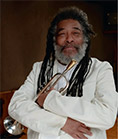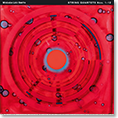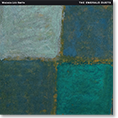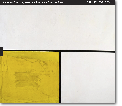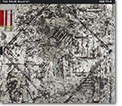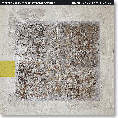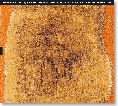THE MUSIC
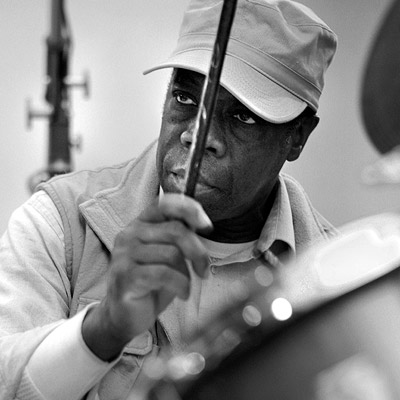
During his trips to Haiti, back to his roots, Andrew Cyrille
could not help but notice the name of a street there: "Route
de Frères (Road of the Brothers)". Though the etymology
was not quite known, the echo of it somehow sparked the
genius and muse of his mind and conscious. The affair,
becoming very philosophical at first, gestated for a while.
We spoke about it then and, "enough is enough", Andrew
decided to put this alluring cultural experience down on
paper. So, here we are: "Route de Frères, Part 1", "Route
de Frères, Part 2" and "Route de Frères, Part 3" were born.
Then came "Hope Springs Eternal" and "Spirit Music".
With the calling on board of the Master of Haitian drums,
Frisner Augustin, and his two vocal contributions, "Marinèt"
and "Ti Kawòl", Andrew´s idea became securely entrenched.
Bluiett added two of his works: "Isaura" and "Sankofa".
Then, it was Lisle´s turn with "C´mon Baby"; whereas I, a
native of Haiti, at the specific request of Andrew, showed
up with "Deblozay (Chaos)", from Ayizan´s notebook,
"Dilijans (Diligence)".
This potpourri of ideas, if I may, within Andrew´s musical
complex, is in sum a cultural odyssey from Haiti, his parents´
homeland, to the United States (Brooklyn, New York - that
is), where he was born and grew up as a musician … .
Enjoy the feast!
New York City, June 1, 2011
Alix Pascal
Andrew Cyrille has long been one of the most respected drummers/percussionists in The Music. One reason is that he can come at you in many ways, his skills are not limited by genre. Even as one of the best known jazz drummers, part of the reputation he has made for himself attests to the fact that Cyrille is one of the most versatile musicians on the scene. This record proves again the truth of that statement. Not only of Cyrille´s obvious percussion skills, of the many "looks" and types of percussion we hear, but also of the quality, yet simplicity, of this group he has gathered.
With baritone saxophonist, Bluiett, still the trailblazer we first heard with David Murray, Oliver Lake and Julius Hemphill in the World Saxophone Quartet. Yet isn´t that avant presence Cyrille´s own persona? It´s a long long time ago now, Andrew might not want to remember himself, when I first dug him playing with Cecil Taylor, a few years before the flood. Bassist, Lisle Atkinson, who´s been around longer than that, one of the stalwarts of the bass, steady as you go, to nail the flashing rhythms and melodies to that stable heartbeat he creates.
The other musicians are Haitian. But
then so is Cyrille, though he was born and raised (like they say) in
Brooklyn (which is said to be part of the United States). He did not
actually get to Haiti until his parents brought him there when he was
seven. The triptych, "Route de Frères", recalls those years, and that
first return to the island of his parents´ birth. The group includes the
Haitian master drummer, Frisner Augustin, who is also the wonderful
singer on "Marinèt, Ou Pa Genyen Pye (Marinette, You Don´t Have Feet)"
and "Ti Maman Kawòl (Little Mama Carole)".
Alix Pascal is a guitarist, whom Cyrille describes as "…extraordinary in his knowledge of Haitian music". Pascal contributed "Deblozay" (Bluesay?), a swift running romantic piece, to the whole. He also commented that, "Andrew could not help but notice the name of a street there: ‘Route de Frères´ (‘Road of the Brothers´) … it somehow sparked the genius and muse of his mind and conscious … very philosophical at first, [it] gestated for a while … . We spoke about it then ... and he decided to put this alluring cultural experience down on paper ... so, here we are …".
That is the living presence, the "vibe" that animates this entire record. The group is called Haitian Fascination for a good reason. Throughout the diverse listens and looks that the album gives us, there is always this Island sway to it. The drumming flows seamlessly throughout, from the hand drum to the set, like the tradition itself.
At times, the record is almost like a reintroduction to the "folk", with always a seasoning of the very new. The new and old restating the obvious linkage, and what "folk" means in this context, "from inside". So that the Bluiett piece "Isaura" is a dance step, so it´s got to be about flinging and turning, and they bring it further north at least as far as Kansas City, or is that East St. Louis?
Cyrille´s "Route de Frères", a three-part recall of his Haitian legacy as remembered as "very rich, pleasant and different experiences for me, being a second grader on vacation from a grammar school in Bedford-Stuyvesant, Brooklyn, New York". The first part ("Hills of Anjubeau") - "Anjubeau … outside of Port-au-Prince … with my Aunt Moreilia (Momo) and my uncle Jules. Because I was a child … my uncle let me ride his horse (wow!)". So, we have the idyllic gliding presence. With "dirt roads … cottages … goats, cows … mules, chameleons … a memorable cock fight … a memorable Vodou ceremony …". It´s almost like a painting.
The second part of "Route de Frères" ("Memories of Port-au-Prince Afternoons") registers Cyrille and his family´s visit to the Haitian nation´s capital, "the daily organization and movement about the city of the people living there". A real jazz feeling to it. Bright and beckoning. "In the afternoons, my aunt would have me change my clothes so that we would go promenading (a daily custom) in town …".
The third part of the tripartite Haitian recall ("Manhattan Swing") imagines what the music must have been like here when Cyrille´s parents came to the United States. "... my father in 1919, my mother in 1926. They met and were married here in the United States, where I was born". Cyrille imagines a hard driving front, like the big band 20´s, to welcome them to the blizzards & funk of America north.
Bluiett´s "Sankofa" (to go back, or into the past, in order to see the future), a term brought into general consciousness by Ethiopian filmmaker Haile Gerima´s film with that title. Literally, to see into Africa´s (everybody´s) past in order to learn about our (everybody´s) present and help plot our future. Bluiett´s piece carries the African feeling in a rhythmically probing mode the bass insists upon.
"Spirit Music" reminds me of the 60´s in Newark when we named our small theater Spirit House. Where drums like these might sound half the night. The Music, especially the drums, is about raising the spirit. As the Africans said: "The spirit cannot descend without song!"
The percussion duo "Mais" is like walking with some musicians through a carnival awakened part of town. We can feel the small throngs welcoming and waving at us, shouting or lilting or even instructing us as we wind happily on our way to see and hear even more.
"Ti Kawòl" is where we might wind up and stand for a time listening to these players; guitar, drums and the horn paraphrasing our own movements as we dig the drums and the hip singers. That feeling of the Afro-Latin gestalt that envelops the whole of the western world.
All these years I have known Andrew, I did not ever think to understand that Cyrille, yeh, obviously was Haitian roots or routes, as he lays it out here. In fact, this whole Mundo Nuevo is an everybody mix. With the African speech, dun dun, at the base, speaking these many thousand years.
Newark, New Jersey, June 8, 2011
Amiri Barak
Marinèt (traditional) is a Haitian folk song about a spirit named Marinèt. The song has long been used in Vodou ceremonies and Frisner Augustin, who occasionally includes the song in his own performances, recalls hearing it already as a young boy.
Marinèt, ou pa genyen pyeFrè Ti Jan, ou pa genyen pye
Kouman ou fè monte kokoye
Nan barye o, o Ti Jan o, nan barye o
Marinette, you don´t have feet
Little Brother John, you don´t have feet
How do you climb the coconut tree
At the gate, oh, oh Little John, oh,
at the gate, oh
Deblozay (Alix Pascal)
Deblozay meaning "Chaos", was first written for Ayizan, a groundbreaking Haitian-influenced jazz group founded by Alix Pascal in 1982. It was also included on Ayizan´s only recording (Dilijans in 1984). Pascal says that the lyrics of the song (here heard as an instrumental version) are about the need for Haitians to speak out their frustration against the chaotic situation in Haiti. Andrew Cyrille was attracted to the lyricism of the melody and asked Pascal to come up with a format suitable for improvisation.
Andrew Cyrille: "This composition is simply my wish for Haiti to prosper in all aspects of its humanity".
Isaura (Hamiet Bluiett)is a song composed by Hamiet Bluiett in the mid-1970s but not previously recorded. Basically, it is a love song for Isaura, a dancer from Rio de Janeiro whom he used to know. Bluiett introduced the song to the Haitian Fascination repertoire because he felt that, due its danceable quality and Afro-Latin influence, it would be a perfect fit for the group.
Route de Frères, Part 1 - Hills of Anjubeau (Andrew Cyrille)Andrew Cyrille: "I first went to Haiti at the age of seven years. I recall going up into the hills of Anjubeau (across La Riviere Froide, outside of Port-au-Prince) with my aunt Moreilia (Momo) and my uncle Jules. Because I was a child and not used to the Haitian terrain, my uncle let me ride on his horse (wow!) There were no cars, only dirt roads to navigate by foot. I remember meeting my ninety year old grandfather, uncles, aunts and cousins I had never seen before; the cottages they lived in, separated by walking distances from each other; the goats, cows, pigs, chickens, horses, donkeys, mules, chameleons and other wild life in the area; the thick vegetation and trees; the farms; a memorable cock fight; a memorable Vodou ceremony; the stark three dimensionality of the countryside; women carrying large baskets of goods on their heads; etc., etc., etc.".
Route de Frères, Part 2 - Memories of Port-au-Prince Afternoons (Andrew Cyrille)
Andrew Cyrille: "I remember being in the nation´s capital, Port-au-Prince, and the daily organization and movement about the city of the people living there. Of course, there were automobiles as well as many of the animals I mentioned under Part 1 above. I remember being awakened in the mornings by roosters crowing; my getting dressed, having breakfast and then going out of the house to play with nearby newly-found friends. In the afternoons, my aunt would have me change my clothes so that we would go promenading (a daily custom) in town and I recall the wonderful people that my aunt and I were staying with. Those were very rich, pleasant and different experiences for me, being a second grader on vacation from a grammar school in Bedford-Stuyvesant, Brooklyn, New York".
Andrew Cyrille: "This part represents what I thought Manhattan could have felt like when my parents landed here by boat, my father in 1919 and my mother in 1926. They met and were married here in the United States, where I was born. They are both now deceased, so I couldn´t ask them directly if the music I wrote is in any way representative of how they felt then. Anyway, I´ve tried to imagine their collective feelings".
C´mon Baby (Lisle Atkinson)C'mon Baby received its title from one of Lisle Atkinson´s favorite phrases ("C´mon man" or "C´mon baby" or some other variation of the theme) that he often uses in stating his position or assuring the other party to the conversation of its correctness. Here, it is the strong bass pattern, played together with Bluiett´s baritone saxophone, that serves to get the point across. "C´mon Baby" was first recorded by Atkinson with his own group in 1978 (Bass Contra Bass).
Sankofa (Hamiet Bluiett)Sankofa is named after a long-necked bird depicted by the Asante with its head turned backwards taking an egg off its back (its literal meaning in the Akan language of Ghana being "Go back and take"). The word symbolizes learning from the past, taking from the past what is good and bringing it to the present. The graceful image of the bird, which sometimes takes a stylized heart shape, is often used in stamped cloth patterns and in craft objects as well as in the traditional weights used to measure gold dust. "Sankofa" was first recorded by its composer, Hamiet Bluiett, in 1979, during the session that resulted in the album S.O.S. (later released as part of the double-CD Im/possible To Keep) and again in 1992 for his album Sankofa/Rear Garde.
Spirit Music (Andrew Cyrille)Andrew Cyrille: "This composition has to do directly with my feelings about the spirits of Africa and Haiti as well as any other good spirits of the world that wish to swing and get down with us".
Mais (Percussion Duo) (Andrew Cyrille and Frisner Augustin)
Mais is a duo improvisation by Andrew Cyrille and Frisner Augustin based upon the Haitian Yanvalou (a word meaning supplication in the speech of Whydah) rhythm. Yanvalou is a ritual dance originating in Benin that honors the spirits.
Ti Kawòl is a composition by Nemours Jean-Baptiste (1918-1985), a popular saxophonist, guitarist, band leader and composer, who is credited with being the inventor of Compas direct, a musical style drawing on both the African and the European roots of Haitian music. Compas, which is typically accompanied by lyrics in the Haitian Creole, was popularized by Jean-Baptiste in the late 1950s and enjoyed its greatest success in the 1960s and 1970s particularly in Haiti and the French Antilles. "Ti Kawòl" was recorded by Jean-Baptiste himself in 1966 for an album named after the tune (Ti Carole). In the mid 1970s, it became a popular hit in France.
Ti Maman Kawòl
Jan Kouri renmen ou
Si Kouri renmen ou
Se pou kapab renmen-n tou
Kouri, si tout bon renmen-n
Al mande maman-n pou li
Kouri pa tande, li pa wè
Se marye bezwen marye
Little Mama Carole
How Kouri loves you
If he loves you
You can love him, too
Kouri, if you´re serious
Go ask her mother for her
Kouri doesn´t understand, doesn´t see
That he needs to marry

